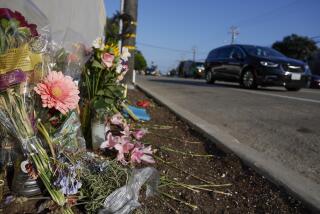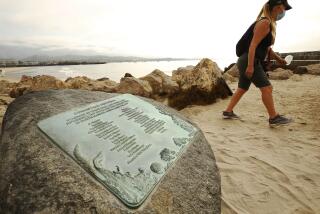Legislator’s Case Study in Deadly Delays
WASHINGTON — Were the consequences not so deadly, the rash of railroad accidents this year might have served as just another example of bureaucratic inertia.
But the congressional inquiry into the crashes, including one in the Cajon Pass in the Inland Empire, provided for one Southern California congressman an embarrassing display of finger-pointing and a case study of how government delay can result in death.
“I am convinced the [Cajon Pass] accident could have been prevented,” said Rep. Jay C. Kim (R-Diamond Bar), who asked for the hearings this month as a member of the House Transportation subcommittee. “How many people have to be killed before a new [safety] ruling comes out?”
During three days of hearings, Kim and other congressmen demanded to know how many of the six derailments of passenger and freight trains since January could have been avoided if proposed regulations had been implemented. Yet, despite testimony from federal investigators, industry regulators and officials for rail companies, public transit agencies and labor unions, Kim complained that he has yet to get a satisfactory answer.
The rail safety issue hit close to home for Kim one morning last month, when a Burlington Northern-Santa Fe train careened out of control as it rounded a curve through the mountain pass that separates the San Gabriel and San Bernardino mountains.
Two railroad workers, including former USC football star Kevin Williams, were killed, and a third was injured. Among the 49 cars and four locomotives were tankers loaded with chemicals that exploded, sending up clouds of toxic fumes and forcing the closure of Interstate 15.
The likely cause, according to investigators: brake failure.
*
It was not the first time a train had derailed in the Cajon Pass, nor was it the first case in which a deficient brake system appeared to cause a derailment. It was, in the eyes of the National Transportation Safety Board, a “preventable” accident.
In written testimony before the House panel, the finger-pointing ensued.
NTSB Chairman James E. Hall told the committee the Federal Railroad Administration had delayed in carrying out new brake system regulations recommended by his agency after a 1989 train collision in Montana.
Then on December 14, 1994, the same day the railroad administration was holding hearings on the proposed regulations, two trains were wrecked in the Cajon Pass. Again, Hall testified, the NTSB urged the railroad administration to take emergency action on the issue of brakes.
The regulators complied, but only after the second Cajon Pass accident, Hall told the House members.
Federal railroad administrator Jolene M. Molitoris conceded that the agency’s relationship with the NTSB “has not always been . . . positive,” but is now better. It is now accepting the safety board’s recommendations 85% of the time, compared to a historical average of 74%, Molitoris told the panel.
Turning attention away from the brake issues, Molitoris said her agency’s investigations into recent rail accidents pointed to “poor communication” between management and workers, who believe the industry sets aside safety concerns in order to “keep the trains moving at all costs.”
Molitoris said a new Railroad Safety Advisory Committee, which includes management and union representatives, is being formed to propose and expedite new safety regulations.
*
The unions, meanwhile, fired criticism in three directions: at Congress for not funding improvements at highway-rail grade crossings, where most accidents occur; at the railroad administration for foot-dragging on other proposed safety regulations, such as those that would protect maintenance workers, and at management.
“We strongly believe these preventable tragedies are manifestations of an entire system designed to run dangerously close to the edge,” testified Mac A. Fleming, president of one of the rail worker unions.
But the rail industry countered by offering a list of research projects now underway to improve workers and passengers’ safety, including an emergency upgrade for the brake systems in response to recent derailments.
“It does not take an act of Congress or federal regulatory action to achieve major safety advances. The railroad industry, itself, produces them,” testified Edwin L. Harper of the Assn. of American Railroads.
This led Kim to conclude: “I haven’t learned a damn thing.” While he agrees the accidents could have been prevented had pending regulations been in place, this conservative, pro-business Republican does not believe that new regulations or increased funding for safety programs are part of the solution. It’s up to all sides--business, labor and the government agencies--to make sure preventable accidents are not repeated.
“They don’t want to come back to Congress again,” said Kim, who faces Upland businessman Bob Kerns in the Republican primary Tuesday. “Next time, we’re going to be very angry.”
More to Read
Sign up for Essential California
The most important California stories and recommendations in your inbox every morning.
You may occasionally receive promotional content from the Los Angeles Times.









